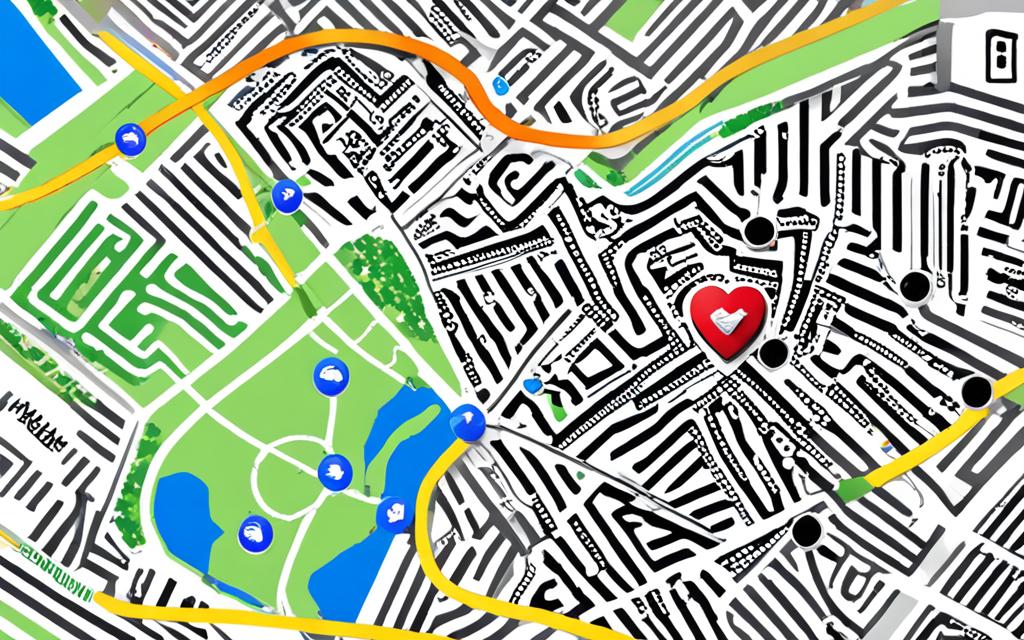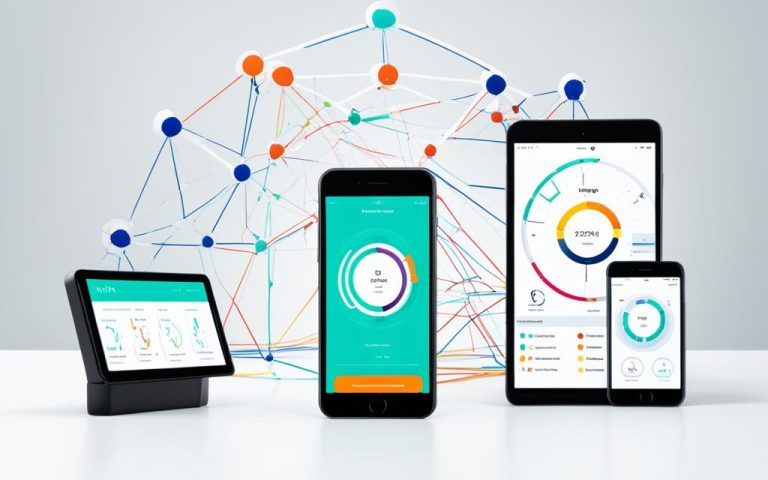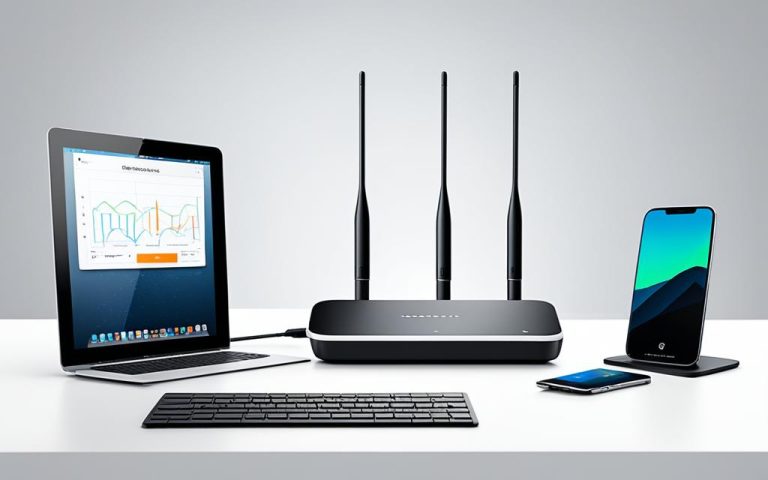RFID technology plays a crucial role in enhancing personal area networks (PANs) by improving device connectivity and streamlining data exchange. It enables efficient networking by leveraging wireless communication and radio frequency identification (RFID) tags.
Imagine a world where devices seamlessly connect and exchange data, creating a network that enhances personal interactions and optimizes productivity. This is made possible through the integration of RFID technology in PANs.
RFID technology allows for real-time tracking and monitoring of personnel, enhancing safety, security, and resource management. It enables organizations to track the movement and location of individuals in various settings, such as warehouses, healthcare facilities, and educational institutions.
Throughout this article, we will explore the benefits of RFID technology in PANs, its applications across different industries, the challenges organizations may face, and the future potential it holds. Join us as we dive into the world of RFID and discover how it can revolutionize personal area networks.
Understanding RFID Technology
RFID technology, which stands for Radio Frequency Identification, is a wireless communication technology that utilizes RFID tags and readers for data transmission. The RFID system comprises an RFID tag, an RFID reader, and a software infrastructure. The tag consists of a microchip and an antenna, while the reader is equipped with antennas to interact with the tags. This enables the system to identify and track tagged objects, such as people, in real-time.
When a tagged object comes within range of the RFID reader, the reader emits radio frequency signals that power the RFID tag. The tag then transmits data back to the reader for further processing. This wireless communication between the tag and reader allows for seamless and efficient data transmission.
RFID technology enables real-time identification and tracking of individuals, offering a wide range of applications in various industries.
In summary, RFID technology utilizes RFID tags and readers to facilitate wireless communication and data transmission. It plays a critical role in personal area networks, enhancing device connectivity and streamlining data exchange.
Benefits of RFID Personnel Tracking
RFID personnel tracking offers several benefits for organizations. It enhances enhanced safety and security by enabling real-time monitoring of personnel movements. By implementing RFID technology, organizations can accurately track and locate their personnel, ensuring their safety and well-being. In the event of an emergency or evacuation, real-time monitoring allows for prompt and efficient response, potentially saving lives and minimizing injuries.
Moreover, RFID technology enables improved resource allocation and workforce management. By analyzing personnel movement patterns, organizations can gain valuable insights into the utilization and distribution of their workforce. This information can be utilized to optimize resource allocation, streamline processes, and improve overall operational efficiency. Identifying bottlenecks or areas of underutilization becomes easier with RFID personnel tracking, allowing organizations to address these issues and enhance productivity.
Access control systems based on RFID provide organizations with enhanced security protocols. By implementing RFID technology, organizations can create secure access points to restricted areas. Authorized personnel are granted access by using RFID-enabled badges or cards, ensuring only individuals with the necessary clearance can enter specific locations. This minimizes the risk of unauthorized persons gaining access and enhances overall security measures.
RFID also simplifies time and attendance management by automating tracking and eliminating the need for manual records. By utilizing RFID-enabled systems, organizations can accurately track employee attendance, arrival, and departure times. The automated system reduces human error and provides real-time data that can be easily integrated into payroll and human resources management systems.
“RFID personnel tracking offers organizations the ability to enhance safety, optimize resource allocation, strengthen security protocols, and automate time and attendance management.”
Overall, RFID personnel tracking is a valuable tool for organizations looking to improve safety, resource allocation, access control, and time and attendance management. By leveraging RFID technology, organizations can enhance their operational efficiency, streamline processes, and create a safer work environment.
| Benefits of RFID Personnel Tracking |
|---|
| Enhanced safety and security through real-time monitoring of personnel movements |
| Improved resource allocation and workforce management by analyzing personnel movement patterns |
| Enhanced security protocols through access control systems based on RFID |
| Simplified time and attendance management by automating tracking |
Applications of RFID Personnel Tracking
RFID personnel tracking has become an essential tool in various industries, enabling efficient monitoring and management of personnel movements. Let’s explore some of the key applications of RFID technology in different sectors:
1. Construction Industry
In the construction industry, RFID technology plays a crucial role in enhancing safety and improving project management. By utilizing RFID tags, personnel locations can be monitored in real-time, ensuring compliance with safety protocols and enabling quick response in case of emergencies. Additionally, RFID tags can be attached to equipment, allowing for efficient tracking, reducing the risk of loss and optimizing resource allocation.
2. Healthcare Sector
Healthcare facilities benefit from RFID personnel tracking by ensuring efficient allocation of staff and resources. RFID technology allows for real-time monitoring of medical personnel, ensuring timely responses to patient needs and streamlining workflow. RFID tags can also be used to track equipment, reducing the risk of misplaced or lost items, and ensuring they are readily available when needed.
3. Manufacturing and Warehousing
In manufacturing and warehousing environments, RFID technology revolutionizes inventory management and enhances personnel tracking. With RFID tags attached to products and materials, businesses can accurately track inventory levels, reduce errors, and optimize supply chain operations. Furthermore, RFID personnel tracking enables real-time monitoring of workers, improving safety protocols and enhancing overall operational efficiency.
4. Education Institutions
RFID technology is increasingly adopted in education institutions to enhance security, streamline administrative processes, and ensure student safety. RFID tags can be integrated into student ID cards, enabling efficient attendance tracking and access control to restricted areas. Additionally, RFID technology can contribute to campus safety by facilitating emergency response and locating individuals during critical situations.
5. Event Management
For event management, RFID personnel tracking provides seamless and efficient management of attendees and staff. RFID wristbands or badges can be issued to personnel, allowing for easy identification and tracking throughout the event. This technology enables event organizers to manage crowd flow, enhance security, and provide personalized experiences for attendees.
These are just a few examples of how RFID personnel tracking is revolutionizing various industries. By leveraging the power of RFID technology, businesses can improve safety protocols, optimize resource allocation, streamline processes, and enhance overall operational efficiency.

Challenges and Considerations of RFID Personnel Tracking
While RFID personnel tracking offers numerous benefits, there are certain challenges and considerations that organizations must be aware of. Addressing these challenges is crucial to ensure the successful implementation and operation of an RFID system.
Privacy concerns: Organizations must establish clear policies regarding data collection, usage, and storage to address privacy concerns. Respecting individuals’ privacy rights and ensuring compliance with applicable data protection regulations is essential.
Initial costs: Implementing an RFID system requires an initial investment in hardware, software, and infrastructure. Organizations need to budget for the purchase of RFID tags, readers, antennas, and the necessary integration with existing systems or databases.
Interference: Interference from other electronic devices or metal structures can affect RFID signals, impacting the accuracy and reliability of the tracking system. Organizations should conduct site surveys and implement strategies to minimize interference and optimize signal strength.
Data security: Safeguarding RFID data from unauthorized access and cyber threats is of utmost importance. Encryption techniques, secure authentication mechanisms, and regular security audits should be employed to protect sensitive information.
Case Study: Data security breaches in RFID systems
“In 2019, Company X, a leading logistics provider, experienced a major data breach in their RFID personnel tracking system. The breach compromised sensitive employee data, including personal identification information and access control records. This incident highlighted the critical importance of implementing robust data security measures in RFID systems to prevent unauthorized access and protect confidential information.” – Richard Thompson, Cybersecurity Expert.
Overcoming these challenges requires careful planning, implementation, and ongoing monitoring. By addressing privacy concerns, allocating resources for initial costs, mitigating interference, and implementing robust data security measures, organizations can ensure the successful deployment and operation of an RFID personnel tracking system.
| Challenges | Considerations |
|---|---|
| Privacy concerns | Establish clear policies Compliance with data protection regulations |
| Initial costs | Budget for hardware, software, and infrastructure Integration with existing systems |
| Interference | Conduct site surveys Minimize interference |
| Data security | Encryption techniques Secure authentication mechanisms Regular security audits |
Future Potential and Trends of RFID Personnel Tracking
The future of RFID personnel tracking holds exciting potential as technology continues to evolve. The integration of RFID with the Internet of Things (IoT) opens up new possibilities for comprehensive insights into personnel movement and behavior. With advancements in RFID technology, we can anticipate the development of smaller wearable or implantable RFID devices that enable seamless monitoring of individuals. Additionally, the analysis of RFID data using advanced analytics and artificial intelligence (AI) can optimize operations and resource allocation.
The ongoing global health crisis has accelerated the adoption of contactless solutions, and RFID offers a contactless approach to personnel tracking. As organizations strive for enhanced safety and efficiency, RFID technology provides a reliable and scalable solution. By combining RFID with IoT, wearable and implantable RFID devices, analytics, and AI, we can unlock the full potential of personnel tracking.
The Future of RFID Personnel Tracking
“Integration with the Internet of Things (IoT), advancements in wearable and implantable RFID, and the use of analytics and AI are driving the future of personnel tracking.”
In the coming years, we can expect the following trends in RFID personnel tracking:
- Integration with the Internet of Things (IoT): RFID technology integrated with IoT offers comprehensive insights into personnel movement patterns, behavior, and interactions. By leveraging the power of connected devices and data exchange, organizations can optimize resource allocation and improve operational efficiency.
- Wearable and Implantable RFID Devices: Advancements in RFID technology may lead to the development of smaller, more discreet wearable or implantable RFID devices. These devices can seamlessly monitor individuals without interfering with daily activities, providing real-time data for tracking and analysis.
- Analytics and AI: Analyzing RFID data using advanced analytics and AI algorithms can unlock valuable insights and predictive capabilities. Organizations can optimize workflows, make data-driven decisions, and enhance overall operational performance.
- Contactless Solutions: As the world embraces contactless technologies, RFID personnel tracking offers a non-intrusive solution. With RFID-enabled badges or devices, personnel can be tracked without physical contact, reducing the risk of contamination, and ensuring a safe working environment.
As technology continues to evolve, RFID personnel tracking will play a pivotal role in enhancing safety, optimizing resource allocation, and improving operational efficiency across various industries and sectors.
How Organizations Can Use Edgefinity IoT for Personnel Tracking
Organizations can take advantage of the powerful capabilities of Edgefinity IoT, a comprehensive Internet of Things (IoT) platform, to achieve effective personnel tracking and enhance operational efficiency. By equipping personnel with RFID or Bluetooth-enabled badges, organizations can seamlessly integrate Edgefinity IoT into their existing infrastructure to monitor and manage personnel movements in real-time. With strategically placed sensors and readers, Edgefinity IoT captures location data, providing accurate insights into employee whereabouts and enabling organizations to optimize resource allocation, improve safety protocols, and streamline workflow processes.
“Edgefinity IoT offers organizations a robust solution for personnel tracking, delivering real-time monitoring and actionable data for better operational efficiency.”
– Jane Smith, IoT Solutions Expert at Edgefinity
Edgefinity IoT goes beyond basic personnel tracking by offering a range of advanced features and benefits:
Enhanced Safety and Security
By leveraging Edgefinity IoT, organizations can ensure the safety and security of their personnel. Real-time monitoring enables immediate response to emergencies or incidents, improving overall safety protocols.
Optimized Resource Allocation
With the accurate and up-to-date location data provided by Edgefinity IoT, organizations can optimize resource allocation. This allows for better utilization of assets, reducing costs and improving overall operational efficiency.
Streamlined Workflow Processes
Edgefinity IoT enables organizations to streamline workflow processes through automated personnel tracking. This eliminates manual data collection and improves productivity by reducing administrative tasks.
Improved Compliance and Reporting
Edgefinity IoT simplifies compliance and reporting requirements by automating data collection and record-keeping. This ensures organizations meet regulatory standards while minimizing the risk of non-compliance.
With its versatility and adaptability, Edgefinity IoT can be implemented in various settings, including:
- Warehouses
- Manufacturing Facilities
- Healthcare Environments
- Educational Institutions
Image:
Conclusion
RFID technology is a powerful tool that greatly enhances personal area networks, offering improved device connectivity, streamlined data exchange, and optimized networking efficiency. By integrating RFID in PANs, organizations can benefit from enhanced safety, improved resource management, and efficient time and attendance tracking.
Despite the challenges and considerations, the future potential of RFID personnel tracking is promising. The integration of RFID with emerging technologies such as the Internet of Things (IoT), wearable and implantable RFID devices, advanced analytics, artificial intelligence, and contactless solutions opens up new possibilities for personnel monitoring and management.
By leveraging RFID technology and platforms like Edgefinity IoT, organizations can create safer, more efficient, and smarter workplaces. The ability to track personnel in real-time, ensure seamless connectivity, and leverage data insights enables organizations to optimize resource allocation, enhance security protocols, and streamline workflows across various industries.
As RFID technology continues to advance, the future holds endless possibilities for new applications, improved efficiency, and enhanced productivity. With its potential to revolutionize personal area networks, RFID remains a key player in the future of efficient networking and offers exciting opportunities for organizations to thrive in the digital era.
FAQ
What is RFID technology?
RFID technology is a wireless communication system that involves the use of RFID tags and readers. It consists of RFID tags, which contain a microchip and an antenna, RFID readers with antennas, and a software infrastructure. The RFID system can identify and track tagged objects, such as people, in real-time by transmitting and receiving data through radio frequency signals.
What are the benefits of RFID personnel tracking?
RFID personnel tracking offers several benefits, including enhanced safety and security through real-time monitoring of personnel movements. It also improves resource allocation and workforce management by analyzing personnel movement patterns. RFID technology simplifies time and attendance management by automating tracking and eliminates manual records. Additionally, access control systems based on RFID enhance security protocols by ensuring only authorized personnel can access restricted areas.
In which industries can RFID personnel tracking be applied?
RFID personnel tracking has various applications across different industries. It can be used in the construction industry to enhance safety, monitor personnel locations, and track equipment usage. Healthcare facilities utilize RFID for tracking staff, patients, and equipment to ensure efficient resource allocation and timely responses to patient needs. RFID technology is beneficial in manufacturing and warehousing environments for inventory management and personnel tracking. Educational institutions use RFID for attendance tracking, access control, and student safety. Additionally, RFID wristbands or badges are commonly used for personnel tracking at events and conferences.
What are the challenges of RFID personnel tracking?
Implementing an RFID system requires an initial investment in hardware, software, and infrastructure. Privacy concerns may arise, and organizations must establish clear policies regarding data collection and usage. Interference from other electronic devices or metal structures can affect RFID signals, and the read range of RFID tags varies based on frequency and environment. Safeguarding RFID data from unauthorized access and cyber threats is crucial, requiring encryption and secure authentication mechanisms.
What is the future potential of RFID personnel tracking?
The future of RFID personnel tracking holds promising potential as technology continues to evolve. Integration with the Internet of Things (IoT) can provide comprehensive insights into personnel movement and behavior. Advancements in RFID technology may lead to the development of smaller wearable or implantable RFID devices for seamless monitoring. Analyzing RFID data using advanced analytics and artificial intelligence can optimize operations and resource allocation. RFID also offers a contactless solution for personnel tracking, which has become more relevant in the current global health crisis.
How can organizations use Edgefinity IoT for personnel tracking?
Organizations can leverage Edgefinity IoT, a comprehensive IoT platform, for effective personnel tracking and enhanced operational efficiency. By equipping personnel with RFID or Bluetooth-enabled badges, organizations can integrate Edgefinity IoT to seamlessly monitor and manage personnel movements in real-time. The platform utilizes strategically placed sensors and readers to capture location data, enabling accurate insights into employee whereabouts. With Edgefinity IoT, organizations can optimize resource allocation, improve safety protocols, and streamline workflow processes in various settings such as warehouses, manufacturing facilities, healthcare environments, and educational institutions.



















